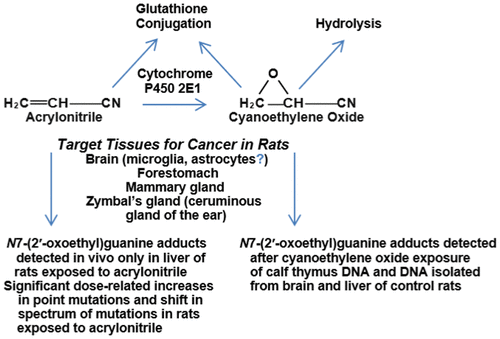当前位置:
X-MOL 学术
›
Chem. Res. Toxicol.
›
论文详情
Our official English website, www.x-mol.net, welcomes your
feedback! (Note: you will need to create a separate account there.)
Analysis of DNA Adducts and Mutagenic Potency and Specificity in Rats Exposed to Acrylonitrile.
Chemical Research in Toxicology ( IF 3.7 ) Pub Date : 2020-06-12 , DOI: 10.1021/acs.chemrestox.0c00153 Vernon E Walker 1, 2, 3 , Timothy R Fennell 1, 4 , Dale M Walker 3, 5 , Michael J Bauer , Patricia B Upton 1, 6 , George R Douglas 7 , James A Swenberg 1, 6
Chemical Research in Toxicology ( IF 3.7 ) Pub Date : 2020-06-12 , DOI: 10.1021/acs.chemrestox.0c00153 Vernon E Walker 1, 2, 3 , Timothy R Fennell 1, 4 , Dale M Walker 3, 5 , Michael J Bauer , Patricia B Upton 1, 6 , George R Douglas 7 , James A Swenberg 1, 6
Affiliation

|
Acrylonitrile (ACN), which is a widely used industrial chemical, induces cancers in multiple organs/tissues of rats by unresolved mechanisms. For this report, evidence for ACN-induced direct/indirect DNA damage and mutagenesis was investigated by assessing the ability of ACN, or its reactive metabolite, 2-cyanoethylene oxide (CEO), to bind to DNA in vitro, to form select DNA adducts [N7-(2′-oxoethyl)guanine, N2,3-ethenoguanine, 1,N6-ethenodeoxyadenosine, and 3,N4-ethenodeoxycytidine] in vitro and/or in vivo, and to perturb the frequency and spectra of mutations in the hypoxanthine-guanine phosphoribosyltransferase (Hprt) gene in rats exposed to ACN in drinking water. Adducts and frequencies and spectra of Hprt mutations were analyzed using published methods. Treatment of DNA from human TK6 lymphoblastoid cells with [2,3-14C]-CEO produced dose-dependent binding of 14C-CEO equivalents, and treatment of DNA from control rat brain/liver with CEO induced dose-related formation of N7-(2′-oxoethyl)guanine. No etheno-DNA adducts were detected in target tissues (brain and forestomach) or nontarget tissues (liver and spleen) in rats exposed to 0, 3, 10, 33, 100, or 300 ppm ACN for up to 105 days or to 0 or 500 ppm ACN for ∼15 months; whereas N7-(2′-oxoethyl)guanine was consistently measured at nonsignificant concentrations near the assay detection limit only in liver of animals exposed to 300 or 500 ppm ACN for ≥2 weeks. Significant dose-related increases in Hprt mutant frequencies occurred in T-lymphocytes from spleens of rats exposed to 33–500 ppm ACN for 4 weeks. Comparisons of “mutagenic potency estimates” for control rats versus rats exposed to 500 ppm ACN for 4 weeks to analogous data from rats/mice treated at a similar age with N-ethyl-N-nitrosourea or 1,3-butadiene suggest that ACN has relatively limited mutagenic effects in rats. Considerable overlap between the sites and types of mutations in ACN-exposed rats and butadiene-exposed rats/mice, but not controls, provides evidence that the carcinogenicity of these epoxide-forming chemicals involves corresponding mutagenic mechanisms.
中文翻译:

暴露于丙烯腈的大鼠的DNA加合物以及诱变力和特异性的分析。
丙烯腈(ACN)是一种广泛使用的工业化学品,它通过未解决的机制在大鼠的多个器官/组织中诱发癌症。对于本报告,通过评估ACN或其活性代谢产物2-氰基环氧乙烷(CEO)在体外与DNA结合形成精选DNA加合物的能力,研究了ACN引起的直接/间接DNA损伤和诱变的证据。 [N7-(2'-氧代乙基)鸟嘌呤,ñ 2,3- ethenoguanine,1,ñ 6 -ethenodeoxyadenosine和3,ñ 4 -ethenodeoxycytidine]在体外和/或体内,并且扰乱突变的频率和频谱黄嘌呤鸟嘌呤磷酸核糖基转移酶(Hprt)暴露于饮用水中ACN的大鼠体内的)基因。Hprt突变的加合物,频率和光谱用已发表的方法进行了分析。用[2,3- 14 C] -CEO处理人TK6淋巴母细胞的DNA产生剂量依赖性结合的14C-CEO等效物,以及CEO诱导的与剂量相关的N7-(2'-氧代乙基)鸟嘌呤形成,处理来自对照大鼠脑/肝脏的DNA。在暴露于0、3、10、33、100或300 ppm ACN长达105天或0或0或0或0的暴露条件下,在目标组织(大脑和前胃)或非目标组织(肝脏和脾脏)中未检测到乙脑DNA加合物。 500 ppm ACN约15个月;而N7-(2'-氧代乙基)鸟嘌呤仅在暴露于300或500 ppm ACN≥2周的动物的肝脏中,在接近检测限的非显着浓度下连续测量。Hprt的剂量相关显着增加在暴露于33–500 ppm ACN的大鼠中,脾脏T淋巴细胞的突变频率出现4周。对照大鼠与暴露于500 ppm ACN 4周的大鼠的“致突变力估计值”与来自相似年龄的用N-乙基-N-亚硝基脲或1,3-丁二烯治疗的大鼠/小鼠的类似数据的比较表明,ACN具有在大鼠中诱变作用相对有限。在暴露有ACN的大鼠和暴露有丁二烯的大鼠/小鼠中,突变的位点和类型之间有相当大的重叠,但没有对照,这提供了证据,表明这些形成环氧化合物的致癌性涉及相应的诱变机制。
更新日期:2020-07-20
中文翻译:

暴露于丙烯腈的大鼠的DNA加合物以及诱变力和特异性的分析。
丙烯腈(ACN)是一种广泛使用的工业化学品,它通过未解决的机制在大鼠的多个器官/组织中诱发癌症。对于本报告,通过评估ACN或其活性代谢产物2-氰基环氧乙烷(CEO)在体外与DNA结合形成精选DNA加合物的能力,研究了ACN引起的直接/间接DNA损伤和诱变的证据。 [N7-(2'-氧代乙基)鸟嘌呤,ñ 2,3- ethenoguanine,1,ñ 6 -ethenodeoxyadenosine和3,ñ 4 -ethenodeoxycytidine]在体外和/或体内,并且扰乱突变的频率和频谱黄嘌呤鸟嘌呤磷酸核糖基转移酶(Hprt)暴露于饮用水中ACN的大鼠体内的)基因。Hprt突变的加合物,频率和光谱用已发表的方法进行了分析。用[2,3- 14 C] -CEO处理人TK6淋巴母细胞的DNA产生剂量依赖性结合的14C-CEO等效物,以及CEO诱导的与剂量相关的N7-(2'-氧代乙基)鸟嘌呤形成,处理来自对照大鼠脑/肝脏的DNA。在暴露于0、3、10、33、100或300 ppm ACN长达105天或0或0或0或0的暴露条件下,在目标组织(大脑和前胃)或非目标组织(肝脏和脾脏)中未检测到乙脑DNA加合物。 500 ppm ACN约15个月;而N7-(2'-氧代乙基)鸟嘌呤仅在暴露于300或500 ppm ACN≥2周的动物的肝脏中,在接近检测限的非显着浓度下连续测量。Hprt的剂量相关显着增加在暴露于33–500 ppm ACN的大鼠中,脾脏T淋巴细胞的突变频率出现4周。对照大鼠与暴露于500 ppm ACN 4周的大鼠的“致突变力估计值”与来自相似年龄的用N-乙基-N-亚硝基脲或1,3-丁二烯治疗的大鼠/小鼠的类似数据的比较表明,ACN具有在大鼠中诱变作用相对有限。在暴露有ACN的大鼠和暴露有丁二烯的大鼠/小鼠中,突变的位点和类型之间有相当大的重叠,但没有对照,这提供了证据,表明这些形成环氧化合物的致癌性涉及相应的诱变机制。









































 京公网安备 11010802027423号
京公网安备 11010802027423号